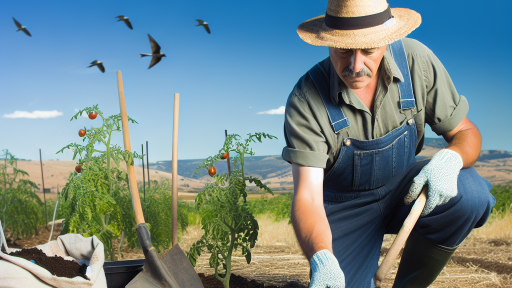Introduction to Food Safety in Agriculture
Importance of Food Safety
Food safety is crucial in agricultural practices to prevent contamination.
It ensures that food products are safe for consumption.
This practice directly affects public health and consumer confidence.
Moreover, food safety standards help maintain market access for farmers.
Adhering to these standards promotes agricultural sustainability.
Key Components of Food Safety
Several key components underpin food safety in agriculture.
First, proper sanitation and hygiene practices are essential.
Farmers must implement effective cleaning procedures for equipment and facilities.
Secondly, safe handling and storage of food products are important.
This includes controlling temperature and humidity levels during storage.
Implementation of Food Safety Standards
The implementation of food safety standards is vital for minimizing risks.
Farmers should undergo regular training on safe agricultural practices.
Additionally, using appropriate labeling and tracking systems is necessary.
These measures help ensure accountability throughout the supply chain.
Regulatory Frameworks and Compliance
Understanding regulatory frameworks is crucial for compliance.
Transform Your Agribusiness
Unlock your farm's potential with expert advice tailored to your needs. Get actionable steps that drive real results.
Get StartedLocal and national regulations set guidelines for food safety practices.
Farmers must stay informed about updates and changes in regulations.
Compliance is not only a legal requirement but also a best practice.
Understanding the Core Principles of Food Safety
What is HACCP?
HACCP stands for Hazard Analysis and Critical Control Points.
This system focuses on preventing food safety problems.
It uses a proactive approach to identify potential hazards.
Moreover, HACCP emphasizes monitoring critical points in the food process.
The Seven Principles of HACCP
First, conduct a hazard analysis to identify potential risks.
Next, determine critical control points (CCPs) for managing those risks.
After that, establish critical limits for each CCP.
Additionally, implement monitoring procedures for each CCP.
Then, develop corrective actions for when monitoring shows an issue.
Furthermore, establish verification procedures to confirm the system works.
Lastly, maintain detailed records and documentation for all procedures.
Application of HACCP in Agriculture
HACCP can be applied at various stages of food production.
Farmers can assess hazards related to soil and water quality.
During planting, monitoring for disease and pests is essential.
Harvesting also requires protocols to prevent contamination.
Additionally, post-harvest handling must maintain food safety standards.
Using HACCP promotes transparency and trust within the food supply chain.
Benefits of Implementing HACCP
First, it helps reduce foodborne illnesses significantly.
Second, it improves compliance with food safety regulations.
This system also enhances product quality and consistency.
Furthermore, it builds consumer confidence in agricultural products.
Showcase Your Farming Business
Publish your professional farming services profile on our blog for a one-time fee of $200 and reach a dedicated audience of farmers and agribusiness owners.
Publish Your ProfileFinally, adopting HACCP can lead to improved market access.
Implementing Good Agricultural Practices for Enhanced Food Safety
Importance of Good Agricultural Practices
Good Agricultural Practices (GAPs) play a crucial role in food safety.
They ensure the production of clean and safe crops.
Additionally, they help minimize foodborne illnesses.
Moreover, GAPs enhance consumer confidence in agricultural products.
Key Components of GAPs
Proper Land and Soil Management
Maintaining soil health is essential for safe food production.
Farmers should use sustainable soil management techniques.
Such practices include crop rotation and cover cropping.
These methods reduce soil erosion and nutrient depletion.
Irrigation Management
Effective irrigation practices prevent water contamination.
Farmers must ensure that irrigation systems are regularly maintained.
Additionally, they should treat irrigation water before use.
This reduces the risk of pathogen introduction into crops.
Pest Management Strategies
Integrated pest management (IPM) is vital for food safety.
IPM combines biological, cultural, and chemical controls.
This approach minimizes pesticide use and protects crops.
Furthermore, it reduces the likelihood of chemical residues.
Regular Training and Education
Farmers and workers need ongoing training in GAPs.
Education raises awareness about food safety standards.
Training sessions should cover handling, sanitation, and hygiene.
Ultimately, knowledgeable staff contribute to safer food products.
Monitoring and Verification
Ongoing monitoring of practices ensures compliance with GAPs.
Farmers should regularly review their safety procedures.
Third-party audits can verify adherence to food safety standards.
These assessments provide accountability and foster improvement.
Documentation and Record Keeping
Maintaining detailed records is essential for traceability.
Farmers should document their agricultural practices regularly.
This includes inputs, processes, and any incidents affecting safety.
Such documentation aids in identifying areas for improvement.
Community and Stakeholder Engagement
Building relationships with local communities enhances food safety.
Farmers should engage with stakeholders and industry experts.
This collaboration fosters shared knowledge and best practices.
Additionally, it strengthens the agricultural safety network.
You Might Also Like: Understanding Label Requirements For Pesticides
The Role of Soil Health and Fertility Management in Food Safety Standards
Importance of Soil Health
Soil health plays a crucial role in food safety standards.
Healthy soil supports the growth of nutritious crops.
Moreover, it prevents the accumulation of harmful pathogens.
Farmers must assess soil health regularly.
Testing can reveal nutrient levels and potential contaminants.
Fertility Management Strategies
Implementing effective fertility management strategies enhances soil health.
Showcase Your Farming Business
Publish your professional farming services profile on our blog for a one-time fee of $200 and reach a dedicated audience of farmers and agribusiness owners.
Publish Your ProfileOrganic fertilizers enrich soil without introducing harmful chemicals.
Crop rotation can prevent nutrient depletion and reduce disease risks.
Furthermore, cover crops improve soil structure and nutrient cycling.
Minimizing Chemical Residue
Reducing chemical use in agriculture is vital for food safety.
Farmers should consider integrated pest management techniques.
These practices can help control pests while minimizing chemical applications.
Additionally, proper timing and application of fertilizers minimize runoff.
Education and Training
Education plays an essential role in maintaining soil health standards.
Farmers should receive training on best practices and innovative techniques.
Workshops and seminars can provide valuable information on new technologies.
Moreover, collaborations with agricultural specialists enhance knowledge sharing.
Monitoring and Compliance
Regular monitoring ensures compliance with food safety standards.
Farmers must document their practices for transparency and accountability.
Participation in certification programs can improve consumer confidence.
Additionally, collaboration with regulatory bodies fosters safer agricultural practices.
Explore Further: Leveraging Research Funding to Innovate and Grow Your Farming Operation
Water Quality Management
Importance of Safe Irrigation Practices
Safe irrigation practices are essential for maintaining food safety standards.
They help prevent contaminating crops with pathogens or pollutants.
Moreover, healthy crops contribute to overall public health.
Farmers play a vital role in ensuring irrigation water quality.
Sources of Irrigation Water
Irrigation water can come from various sources.
Examples include groundwater, surface water, and treated wastewater.
Each source has specific safety considerations.
Groundwater
Groundwater is often considered a safe irrigation option.
It typically has lower contaminant levels compared to surface water.
Regular testing is crucial to identify any emerging contaminants.
Surface Water
Surface water, such as rivers and lakes, requires careful management.
This water source can easily be contaminated by runoff.
Farmers should monitor nearby agricultural and industrial activities.
Treated Wastewater
Treated wastewater is increasingly utilized in agriculture.
However, it must meet specific safety standards before use.
Farmers should verify treatment processes to ensure water safety.
Testing and Monitoring Water Quality
Regular testing of irrigation water ensures safety and compliance.
Testing for pathogens, pesticides, and heavy metals is essential.
Farmers should document results and conduct tests regularly.
Adopting a proactive monitoring approach is vital for prevention.
Best Practices for Irrigation Water Management
Implementing best practices can enhance irrigation safety.
- Utilize filtration systems to remove contaminants.
- Schedule irrigation wisely to reduce runoff.
- Establish buffer zones around water sources.
- Educate farm workers on safe practices.
These practices promote sustainable agriculture and safe food production.
Collaboration with Local Authorities
Farmers should collaborate with local authorities to enhance water management.
Partnerships can lead to shared resources and information.
Showcase Your Farming Business
Publish your professional farming services profile on our blog for a one-time fee of $200 and reach a dedicated audience of farmers and agribusiness owners.
Publish Your ProfileEngaging with water management agencies can provide new insights.
Furthermore, these collaborations can facilitate access to funding.
Training and Education
Ongoing education about water safety is crucial for farmers.
Participating in workshops can improve knowledge on water management.
Additionally, resources from agricultural extension services can be valuable.
Farmers should encourage their peers to engage in these learning opportunities.
Learn More: The Role of Animal Welfare Laws in Modern Farming Practices
Pest Management and Its Impact on Food Safety
Integrated Pest Management Strategies
Pest management plays a critical role in ensuring food safety.
Integrated Pest Management (IPM) is an effective strategy for managing pests.
IPM combines various management approaches for optimal results.
Biological control methods help reduce pest populations naturally.
This method uses natural predators or parasites to suppress pests.
Cultural practices also play a significant role in IPM strategies.
Crop rotation disrupts pest life cycles and reduces infestations.
Sanitation measures eliminate food sources and breeding grounds for pests.
Moreover, proper storage practices can prevent pest access to food products.
Monitoring and Assessment Techniques
Regular monitoring is essential to effective IPM implementation.
Farmers use traps and visual inspections to monitor pest numbers.
Identifying pest species allows for better management decisions.
Assessment should occur throughout the growing season.
Consistent data collection leads to informed pest management choices.
Chemical Control Measures
In some cases, chemical controls remain necessary for pest management.
IPM emphasizes the judicious use of pesticides to minimize risks.
Farmers must select pesticides that target specific pests.
This approach reduces the impact on beneficial organisms in the ecosystem.
Additionally, safe application techniques ensure minimal residue on food.
Training and Education for Farmers
Education is crucial in implementing IPM effectively.
Farmers need training in recognizing pest species and their life cycles.
Workshops and extension services provide valuable information.
Collaborating with agricultural organizations enhances learning opportunities.
Continued education keeps farmers updated on the latest practices.
Explore Further: Understanding Climate Change Laws for Modern Farmers

Training and Education: Equipping Farmers and Workers with Food Safety Knowledge
The Importance of Food Safety Training
Food safety training is crucial for farmers and agricultural workers.
It equips them with essential knowledge on handling food safely.
Consequently, it reduces the risk of foodborne illnesses.
Additionally, informed workers can prevent contamination during cultivation.
Types of Training Programs
Various training programs exist to address food safety standards.
Workshops and seminars can provide hands-on experiences.
Online courses offer flexibility for busy farmers.
Furthermore, training sessions can include certification programs.
Showcase Your Farming Business
Publish your professional farming services profile on our blog for a one-time fee of $200 and reach a dedicated audience of farmers and agribusiness owners.
Publish Your ProfileKey Topics Covered in Training
Food safety training encompasses several vital topics.
- Proper hygiene practices for workers.
- Safe handling and storage of produce.
- Effective pest control measures.
- Understanding food hazard analysis.
Moreover, it emphasizes the importance of record-keeping.
Incorporating Technology in Training
Technology plays a significant role in modern training programs.
Virtual reality can simulate real-life scenarios for effective learning.
Mobile apps provide quick access to food safety resources.
Additionally, webinars allow for continued education from experts.
Engagement with Local Agricultural Institutions
Collaboration with agricultural institutions enhances training efforts.
Local universities often offer valuable resources and expertise.
Partnerships can lead to improved training materials.
As a result, farmers receive up-to-date information and assistance.
Continuous Improvement and Feedback
Regular updates to training programs are essential.
Feedback from participants helps refine the material.
Also, staying informed about current regulations is vital.
Therefore, continuous education ensures ongoing compliance.
Monitoring and Record-Keeping: Essential Practices for Compliance and Traceability
The Importance of Monitoring in Agriculture
Monitoring is vital for maintaining food safety standards.
It helps identify potential hazards in agricultural practices.
This proactive approach minimizes risks related to foodborne illnesses.
Regular monitoring ensures compliance with safety regulations.
Moreover, it fosters consumer confidence in food safety.
Effective Record-Keeping Practices
Accurate record-keeping is crucial for traceability in agriculture.
Farmers should document every stage of production.
This includes planting, harvesting, and packaging processes.
Detailed records facilitate quick responses to safety concerns.
Additionally, they support audits and inspections.
Technological Tools for Monitoring and Record-Keeping
Technology enhances monitoring and record-keeping practices.
Farm management software can streamline data collection.
Mobile apps allow farmers to log information in real time.
These tools can also generate reports for regulatory compliance.
Utilizing technology reduces human error in data entry.
Training and Education for Agricultural Workers
Training is essential for effective monitoring and record-keeping.
A knowledgeable workforce understands food safety protocols.
Regular training sessions keep staff updated on regulations.
Informed employees are better equipped to spot issues early.
Investing in education yields better food safety outcomes.
Creating a Culture of Food Safety
Establishing a culture of food safety is critical in agriculture.
All team members should feel responsible for food safety standards.
Encouraging open communication fosters a proactive safety environment.
Recognizing safe practices boosts morale and compliance.
Leadership should model commitment to safety at all levels.
Emergency Preparedness: Strategies for Addressing Food Safety Crises in Agriculture
Importance of Emergency Preparedness
Emergency preparedness is crucial for maintaining food safety in agriculture.
Showcase Your Farming Business
Publish your professional farming services profile on our blog for a one-time fee of $200 and reach a dedicated audience of farmers and agribusiness owners.
Publish Your ProfileIt helps minimize the impact of food safety crises.
Moreover, it enhances the resilience of agricultural practices.
Developing an Emergency Response Plan
A robust emergency response plan is fundamental for farmers and producers.
This plan should outline specific protocols for various food safety threats.
Additionally, regular drills ensure the plan is effective and updated.
Identifying Potential Risks
Identifying potential risks is the first step in developing an emergency response plan.
Common risks include contamination, natural disasters, and equipment failures.
Understanding these risks can help optimize preparedness efforts.
Establishing Communication Protocols
Clear communication is essential during a food safety crisis.
Establish a chain of command for effective information sharing.
Regular updates keep all stakeholders informed and ready to act.
Training and Education
Training staff and stakeholders is a key component of food safety preparedness.
Workshops and seminars enhance understanding of safety protocols.
Ongoing education fosters a culture of safety within agricultural operations.
Engaging with Local Health Authorities
Engaging with local health authorities strengthens emergency preparedness.
Collaboration ensures access to expert resources and support.
Additionally, it helps streamline communication during emergencies.
Regular Simulation Exercises
Conducting regular simulation exercises tests the effectiveness of emergency plans.
These exercises reveal gaps and areas for improvement.
Moreover, they increase familiarity with emergency procedures among staff.
Monitoring and Evaluation
Monitoring and evaluation are vital for ongoing improvement.
Collect data on the effectiveness of implemented strategies.
Regular reviews help refine emergency response plans.
Feedback Mechanisms
Establishing feedback mechanisms allows stakeholders to share insights.
Constructive feedback leads to improved practices and preparedness.
Encouraging open communication fosters a proactive culture.
Staying Informed on Food Safety Regulations
Keeping up-to-date with food safety regulations is necessary.
Changes in legislation can impact emergency response strategies.
Familiarity with regulations helps ensure compliance during crises.
Additional Resources
Good Agricultural Practices (GAP) Audits | Agricultural Marketing …




